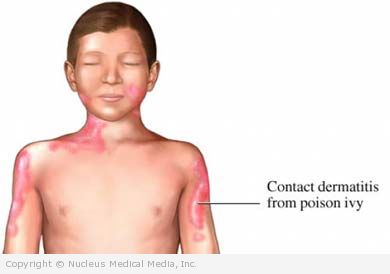Contact Dermatitis – Definition
Contact dermatitis is inflammation of the outer layers of the skin caused by contact with a particular substance. It usually presents as a rash that is typically confined to the specific area of the body where the contact occurred.
Contact Dermatitis – Causes
Contact dermatitis is usually caused by either an irritant or an allergen. An irritant is a substance that irritates the skin. An allergen is a substance that causes an allergic reaction. People may be exposed to certain substances for years and never have a problem, and then suddenly develop contact dermatitis.
Some common causes of contact dermatitis include:
- Acids
- Alkalis
- Solvents
- Acetone
- Soaps
- Detergents
- Metals, such as nickel (common in jewelry allergy)
- Rubber
- Latex
- Cosmetics and toiletries
- Deodorants
- Preservatives
- Plants, such as poison ivy
- Medications
Contact Dermatitis – Risk Factors
A risk factor is something that increases your chance of getting a disease or condition.
- Contact with an irritant or allergen
- Allergies to certain substances, such as plants, chemicals, or medications
Contact Dermatitis – Symptoms
The symptoms of contact dermatitis may vary from person to person. Scratching and rubbing can cause or worsen some symptoms. The rash is usually confined to the area where the contact with the substance occurred, but occasionally may spread. If contact with the substance occurred all over the body, such as with a body lotion, the rash may be large.
Symptoms include:
- Itching
- Redness
- Swelling
- Blisters
- Crusting, oozing, and scaling
- Temporary thickening of the skin
Contact Dermatitis – Diagnosis
Your doctor will ask about your symptoms and medical history, and perform a physical exam. You may be referred to a doctor who specializes in skin disorders (dermatologist) or allergies (allergist).
Contact Dermatitis – Treatment
The primary goal of treatment is to identify the substance causing the reaction and remove or avoid it. This could take several days or weeks of avoiding certain substances.
If you cannot identify the cause of your skin reaction, you may need to undergo a skin patch test. In a patch test, a small amount of the suspected substance is applied to the skin and covered with tape. Another patch without the substance on it is also attached to the skin. Both patches are removed after a period of time. If your skin is red and swollen under the suspect patch, and not under the other patch, you are probably allergic to that substance.
Treatment also focuses on caring for skin and relieving symptoms. Methods include:
Skin Care
- Wash the area with water and mild soap or cleanser and gently pat dry.
- Apply a barrier ointment such as petrolatum or vaseline.
- Do not poke at or cut open blisters. They can become infected.
- Cover blisters with dry bandages.
Medications
Do not use any of these medications until after you have discussed them with your doctor.
- Over-the-counter or prescription creams and ointments containing cortisone
- Prescription medications containing corticosteroids, such as prednisone (for severe cases)
- Prescription or over-the-counter antihistamines (may relieve itching in some cases, but not always useful for contact dermatitis)
- Phototherapy or immunosuppressants, such as menthotrexate or cyclosporine, in the most severe, resistant, and chronic cases
Contact Dermatitis – Prevention
To prevent contact dermatitis:
- Identify the allergens and irritants that cause the condition and try to avoid them.
- If you have to come into contact with these substances, wear gloves and protective clothing.
- Use protective skin cream and take care of your skin.

